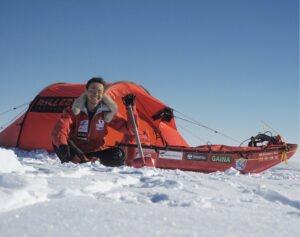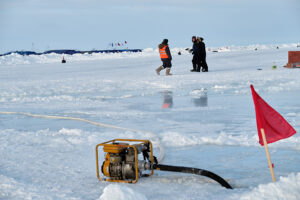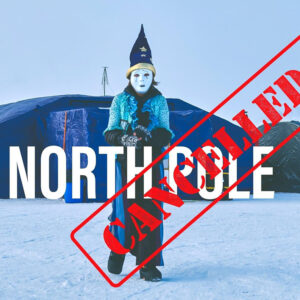From his home in Iqaluit, on southern Baffin Island, René Ritter seems ideally placed for polar travel. Yet the 43-year old Canadian became an adventurer by chance. He’d never done much outdoors, apart from day hikes and the odd overnighter, when he happened to move close to the McNair-Landry family of polar guides and adventurers. Under their tutelage, Ritter learned to drive dog teams and has since explored the mountains of Baffin and Ellesmere Islands and crossed the Greenland icecap. Now he’s about to begin a long-term project to loosely follow the Northwest Passage by ski, packraft and kite. The 2,500km journey kicks off on April 11, with a 435km first leg.
Ritter is not the only person to tackle the fabled Northwest Passage in stages. Because of its length, it’s often done that way. The spring season is a little short for sledding the entire route, and open water in summer is too brief and uncertain for kayaking great distances. In the mid-1980s, Jeff McInnis and Mike Beedell took three seasons to complete the Passage by catamaran. In the 1990s, disaster adventurer Don Starkell almost kayaked it in the three summers, before losing fingers and toes to frostbite when he became iced-in just 50km from his endpoint in the western Arctic. The only adventurers to cover the Passage in a single season were Ritter’s friends and teachers, Sarah and Eric McNair-Landry, by kite-ski.

Soft snow, big vistas. Photo: René Ritter
Ritter moved to Nunavut a decade ago to teach school. In 2016, he started a business instructing the public, firefighters and first responders in wilderness medicine and safety. Meanwhile, moving close to the McNair-Landrys had started his love for “the land”, as the local Inuit call it.
“Initially, I thought: why are you people doing this stuff? And then all of a sudden, I’m doing it,” he recalled.

Rolling, rolling, rolling on the sea ice. Photo: René Ritter
Now versed in polar travel, Ritter’s plan is to cross parts of the Northwest Passage between 2019 and 2021. April and May are favorite travel months in the Canadian High Arctic, because you can walk or ski on sea ice, the sun has returned and April is not as cold as March. He also has one backpacking/packraft leg in summer.
This April, Ritter plans to ski 435km from Kugluktuk, in the western Arctic, to Cambridge Bay. The following year, a winter/early spring ski expedition takes him from Cambridge Bay to Taloyoak. A few months later, he’ll packraft and hike from Taloyoak to Kugaaruk (formerly, Pelly Bay). Finally, “the long stretch”: skiing and kiting north in 2021 to Hall Beach and Igoolik, then across Baffin Island to Pond Inlet.
Technically, the route does not adhere to the Northwest Passage after midway through Leg 2. Here, the Passage turns north, while Ritter heads south, because he wants to include some overland travel in his project rather than stick slavishly to the ocean. But Kugluktuk is usually considered the waterway’s western terminus, and Pond Inlet is the eastern terminus. The total route is about 2,500km.

Leg 1: Ski/walk Kugluktuk to Cambridge Bay in April 2019; Leg 2: Ski Cambridge Bay to Taloyoak in winter/spring 2020, and then packraft Taloyoak to Kugaaruk in summer 2020; Leg 3: Ski/kite Taloyoak to Hall Beach/Igoolik, then on o Pond Inlet in winter/spring 2021. Photo: Ash Routen
For his relatively short Leg 1, Ritter is packing 23 days of food and will travel almost the entire way on sea ice. First he crosses Coronation Gulf to Victoria Island, then follows the shoreline east to Cambridge Bay. This route minimizes the chance of run-ins with polar bears, according to a local friend, but he’ll rent a working dog from an outfitter and carry a gun as a last resort.

The route from Kugluktuk to Cambridge Bay. Photo: Ash Routen
With the hectic last-minute expedition preparations in full swing, Ritter is looking forward to the simple pleasure of being out in the wilderness alone: “When you speak to some people about the Arctic, they think it’s a wasteland and dead. I think this comes from a lack of exposure to the true beauty and uniqueness of the land and its people. I hope to help change that in undertaking this adventure.” Through his Facebook page called Polar Ed, his Twitter handle @arctic_rene and his Instagram name @polar_ritter1, he wants to help educate southerners about the Arctic. He might have left the world of teaching behind, but it seems that René Ritter hasn’t quite lost his passion for educating others.

Sweet nothings from a working dog. Photo: René Ritter






